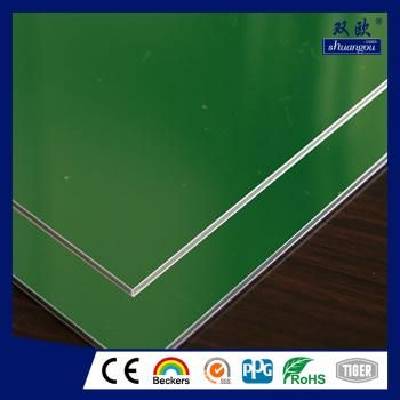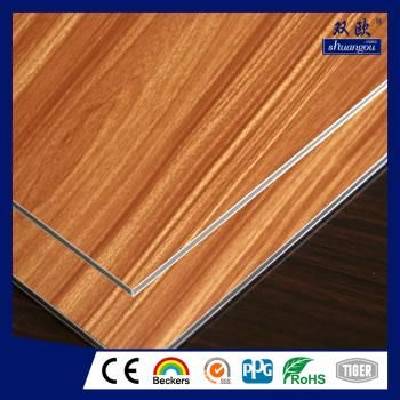Do you know the difference between aluminum plate and aluminum-plastic plate? Aluminum plate is a pure metal aluminum plate construction and decoration material that is processed by chromium and other treatments and then uses fluorocarbon spraying technology. The aluminum-plastic panel is a composite material processed on a special aluminum-plastic panel production equipment with a chemically treated coated aluminum panel as the surface material and polyethylene plastic as the core material. So, what is the difference between aluminum plate and aluminum composite panel? Aluminum Composite Panel Suppliers will answer for you:

Aluminum Composite Panel
The aluminum plate generally adopts 2-4mm thick AA1100 pure aluminum plate or AA3003 aluminum alloy plate, and 2.5mm thick AA3003 aluminum alloy plate is generally used in China; the aluminum-plastic plate generally adopts 3-4mm three-layer structure, including the upper and lower 0.5mm sandwiched PVC Or PE. We can see from the materials that the cost of aluminum-plastic panels is definitely much lower than that of Aluminum Veneer.
At present, domestic aluminum plates mainly use fluorocarbon sprayed aluminum plates. The processing process includes sheet metal processing and spraying. Sheet metal processing mainly involves cutting, folding, bending, welding, and polishing the plates to process the aluminum plates into construction needs The shape and size; spraying is to spray paint on the processed sheet metal, one is manual spraying, the other is machine spraying. Machine spraying is generally only suitable for regular plates. One of the advantages of manual spraying is that the color can be chosen regardless of the amount.
The roll coating of aluminum composite panels must reach a certain amount before they can be processed. The processing process of aluminum composite panels is more complicated than that of aluminum panels. There are mainly four major processes of formation, coating, compounding and trimming. These four processes are in addition to trimming. Others are automated production. It can be seen from the processing process that aluminum-plastic panels have certain advantages in environmental protection and safety. Coupled with the simplicity of the sheet metal processing of aluminum plates, some private workshops have also begun to get involved, which has seriously affected the stability of the market quality of aluminum plates.

Fire-Proof Aluminium Composite Panel
The appearance of aluminum plate is worse than that of aluminum-plastic plate, but its mechanical properties are obviously better than that of aluminum-plastic plate, and its wind resistance performance is also better than that of aluminum-plastic plate.
Fire-Proof Aluminium Composite Panel are non-flammable. The early aluminum-plastic panels are not fire-resistant, but with the development of aluminum-plastic panel technology, the fire-resistant aluminum-plastic composite panels produced now are due to the addition of non-toxic flame-retardant materials to their PE , The fire performance is greatly improved, and it can fully meet the needs of engineering fire protection. The residual value aluminum plate has a certain residual value, but due to its high cost, compared to the aluminum-plastic composite plate with almost no residual value, the waste caused is still much larger.
The above is about the difference between aluminum plate and aluminum composite panel. In summary, aluminum plate and aluminum composite panel have their own advantages, but from a large perspective, the application of aluminum composite panel should be more affordable and environmentally friendly.
Copyright © Changzhou Shuangou Flooring Co., Ltd. All Rights Reserved | Sitemap
